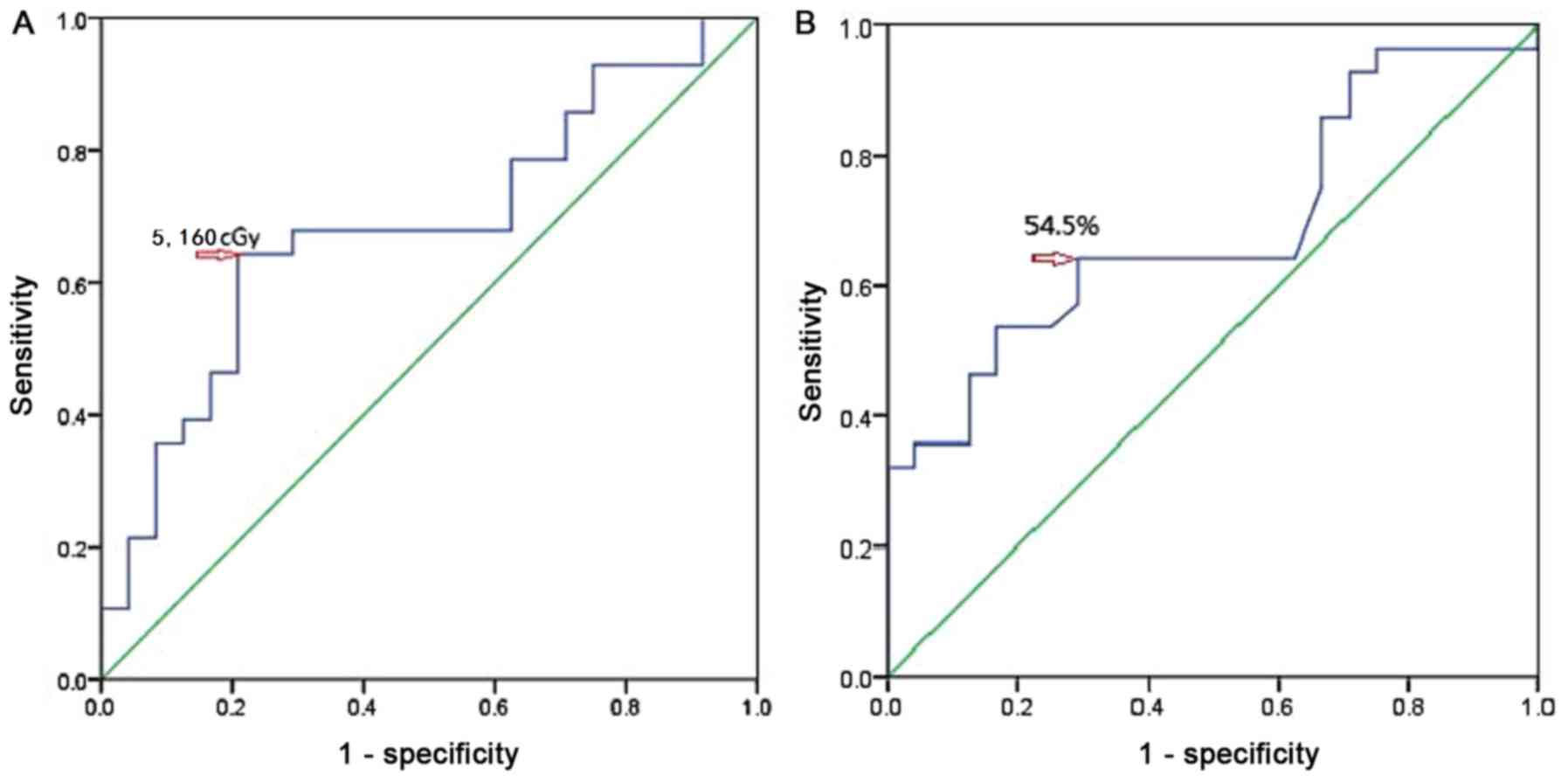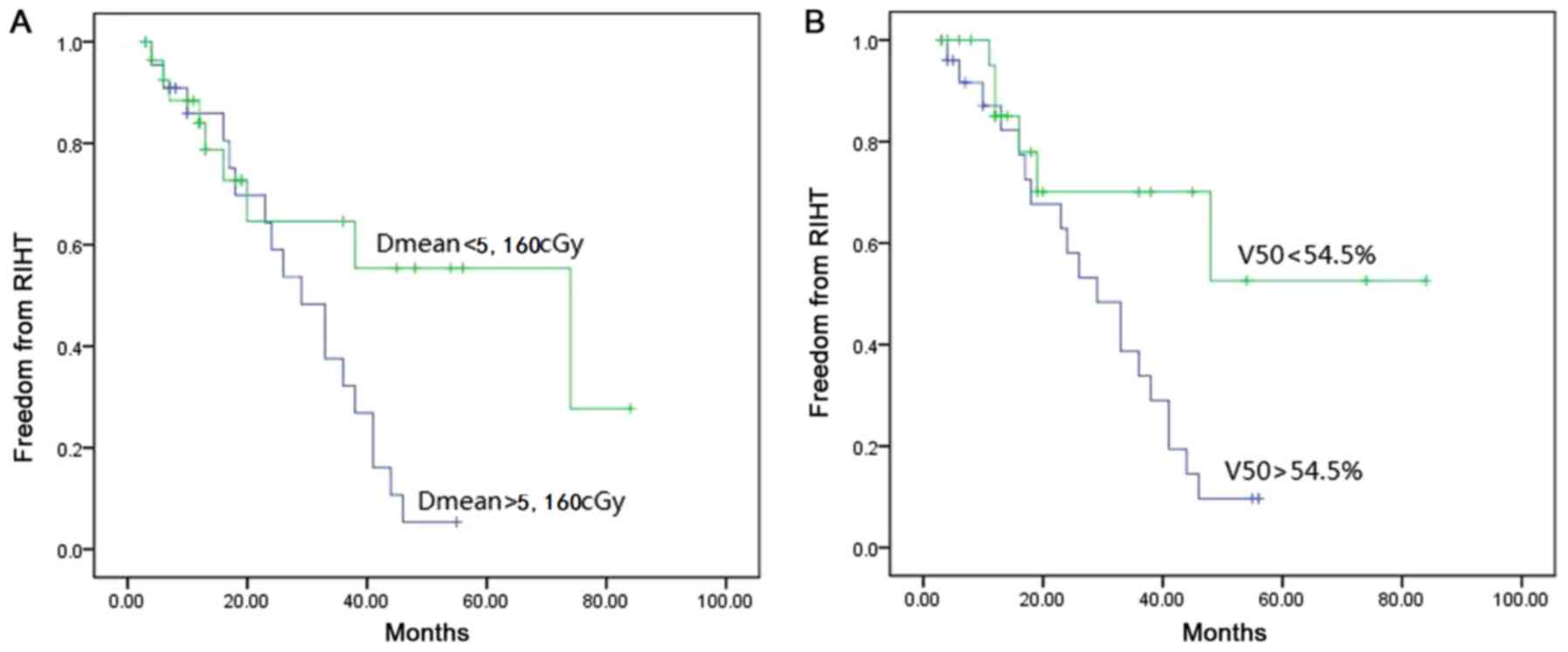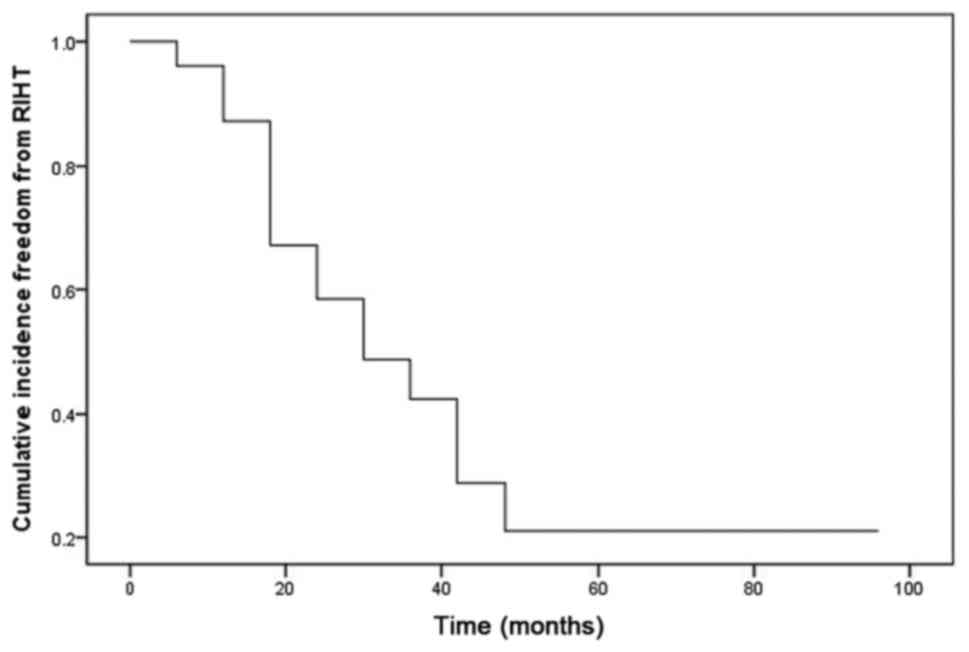|
1
|
Yi HM, Yi H, Zhu JF, Xiao T, Lu SS, Guan
YJ and Xiao ZQ: A five-variable signature predicts radioresistance
and prognosis in nasopharyngeal carcinoma patients receiving
radical radiotherapy. Tumour Biol. 37:2941–2949. 2016. View Article : Google Scholar : PubMed/NCBI
|
|
2
|
Boomsma MJ, Bijl HP and Langendijk JA:
Radiation-induced hypothyroidism in head and neck cancer patients:
A systematic review. Radiother Oncol. 99:1–5. 2011. View Article : Google Scholar : PubMed/NCBI
|
|
3
|
Vanderpump MP and Tunbridge WM:
Epidemiology and prevention of clinical and subclinical
hypothyroidism. Thyroid. 12:839–847. 2002. View Article : Google Scholar : PubMed/NCBI
|
|
4
|
Edge SB, Byrd DR, Compton CC, Fritz AG,
Greene FL and Trotti A: AJCC cancer staging manual. 7th.
Springer-Verlag; New York, NY: 2010
|
|
5
|
Tian YM, Xiao WW, Bai L, Liu XW, Zhao C,
Lu TX and Han F: Impact of primary tumor volume and location on the
prognosis of patients with locally recurrent nasopharyngeal
carcinoma. Chin J Cancer. 34:247–253. 2015. View Article : Google Scholar : PubMed/NCBI
|
|
6
|
Duntas LH and Brenta G: The effect of
thyroid disorders on lipid levels and metabolism. Med Clin North
Am. 96:269–281. 2012. View Article : Google Scholar : PubMed/NCBI
|
|
7
|
Laulund AS, Nybo M, Brix TH, Abrahamsen B,
Jørgensen HL and Hegedüs L: Duration of thyroid dysfunction
correlates with all-cause mortality. The OPENTHYRO register cohort.
PLoS One. 9:e1104372014. View Article : Google Scholar : PubMed/NCBI
|
|
8
|
Amin MB, Edge S, Greene F, Byrd DR,
Brookland RK, Washington MK, Gershenwald JE, Compton CC, Hess KR,
Sullivan DC, et al: AJCC Cancer Staging Manual. Eigth edition.
Springer-Verlag; New York, NY: 2017, View Article : Google Scholar
|
|
9
|
Zohar Y, Tovim RB, Laurian N and Laurian
L: Thyroid function following radiation and surgical therapy in
head and neck malignancy. Head Neck Surg. 6:948–952. 1984.
View Article : Google Scholar : PubMed/NCBI
|
|
10
|
Hancock SL, Cox RS and McDougall IR:
Thyroid disease after treatment of Hodgkin'S disease. N Engl J Med.
325:599–605. 1991. View Article : Google Scholar : PubMed/NCBI
|
|
11
|
Peng YL, Chen L, Shen GZ, Li YN, Yao JJ,
Xiao WW, Yang L, Zhou S, Li JX, Cheng WQ, et al: Interobserver
variations in the delineation of target volumes and organs at risk
and their impact on dose distribution in intensity-modulated
radiation therapy for nasopharyngeal carcinoma. Oral Oncol. 82:1–7.
2018. View Article : Google Scholar : PubMed/NCBI
|
|
12
|
Mercado G, Adelstein DJ, Saxton JP, Secic
M, Larto MA and Lavertu P: Hypothyroidism: A frequent event after
radiotherapy and after radiotherapy with chemotherapy for patients
with head and neck carcinoma. Cancer. 92:2892–2897. 2001.
View Article : Google Scholar : PubMed/NCBI
|
|
13
|
Tell R, Lundell G, Nilsson B, Sjödin H,
Lewin F and Lewensohn R: Long-term incidence of hypothyroidism
after radiotherapy in patients with head-and-neck cancer. Int J
Radiat Oncol Biol Phys. 60:395–400. 2004. View Article : Google Scholar : PubMed/NCBI
|
|
14
|
Cella L, Liuzzi R, Conson M, D'Avino V,
Salvatore M and Pacelli R: Development of multivariate NTCP models
for radiation-induced hypothyroidism: A comparative analysis.
Radiat Oncol. 7:2242012. View Article : Google Scholar : PubMed/NCBI
|
|
15
|
Feen Rønjom M: Radiation-induced
hypothyroidism after treatment of head and neck cancer. Dan Med J.
63:2016.
|
|
16
|
Lin Z, Wu VW, Lin J, Feng H and Chen L: A
longitudinal study on the radiation-induced thyroid gland changes
after external beam radiotherapy of nasopharyngeal carcinoma.
Thyroid. 21:19–23. 2011. View Article : Google Scholar : PubMed/NCBI
|
|
17
|
Tell R, Sjödin H, Lundell G, Lewin F and
Lewensohn R: Hypothyroidism after external radiotherapy for head
and neck cancer. Int J Radiat Oncol Biol Phys. 39:303–308. 1997.
View Article : Google Scholar : PubMed/NCBI
|
|
18
|
Diaz R, Jaboin JJ, Morales-Paliza M,
Koehler E, Phillips JG, Stinson S, Gilbert J, Chung CH, Murphy BA,
Yarbrough WG, et al: Hypothyroidism as a consequence of
intensity-modulated radiotherapy with concurrent taxane-based
chemotherapy for locally advanced head-and-neck cancer. Int J
Radiat Oncol Biol Phys. 77:468–476. 2010. View Article : Google Scholar : PubMed/NCBI
|
|
19
|
Colevas AD, Read R, Thornhill J, Adak S,
Tishler R, Busse P, Li Y and Posner M: Hypothyroidism incidence
after multimodality treatment for stage III and IV squamous cell
carcinomas of the head and neck. Int J Radiat Oncol Biol Phys.
51:599–604. 2001. View Article : Google Scholar : PubMed/NCBI
|
|
20
|
Wu YH, Wang HM, Chen HH, Lin CY, Chen EY,
Fan KH, Huang SF, Chen IH, Liao CT, Cheng AJ and Chang JT:
Hypothyroidism after radiotherapy for nasopharyngeal cancer
patients. Int J Radiat Oncol Biol Phys. 76:1133–1139. 2010.
View Article : Google Scholar : PubMed/NCBI
|
|
21
|
Murthy V, Narang K, Ghosh-Laskar S, Gupta
T, Budrukkar A and Agrawal JP: Hypothyroidism after 3-dimensional
conformal radiotherapy and intensity-modulated radiotherapy for
head and neck cancers: Prospective data from 2 randomized
controlled trials. Head Neck. 36:1573–1580. 2014. View Article : Google Scholar : PubMed/NCBI
|
|
22
|
August M, Wang J, Plante D and Wang CC:
Complications associated with therapeutic neck radiation. J Oral
Maxillofac Surg. 54:1409–1416. 1996. View Article : Google Scholar : PubMed/NCBI
|
|
23
|
Grande C: Hypothyroidism following
radiotherapy for head and neck cancer: Multivariate analysis of
risk factors. Radiother Oncol. 25:31–36. 1992. View Article : Google Scholar : PubMed/NCBI
|
|
24
|
Cella L, Conson M, Caterino M, De Rosa N,
Liuzzi R, Picardi M, Grimaldi F, Solla R, Farella A, Salvatore M
and Pacelli R: Thyroid V30 predicts radiation-induced
hypothyroidism in patients treated with sequential
chemo-radiotherapy for Hodgkin's lymphoma. Int J Radiat Oncol Biol
Phys. 82:1802–1808. 2012. View Article : Google Scholar : PubMed/NCBI
|
|
25
|
Kim MY, Yu T and Wu HG: Dose-volumetric
parameters for predicting hypothyroidism after radiotherapy for
head and neck cancer. Jpn J Clin Oncol. 44:331–337. 2014.
View Article : Google Scholar : PubMed/NCBI
|
|
26
|
Sachdev S, Refaat T, Bacchus ID,
Sathiaseelan V and Mittal BB: Thyroid V50 highly predictive of
hypothyroidism in head-and-neck cancer patients treated with
intensity-modulated radiotherapy (IMRT). Am J Clin Oncol.
40:413–417. 2017. View Article : Google Scholar : PubMed/NCBI
|
|
27
|
Boomsma MJ, Bijl HP, Christianen ME, Beetz
I, Chouvalova O, Steenbakkers RJ, van der Laan BF, Wolffenbuttel
BH, Oosting SF, Schilstra C and Langendijk JA: A prospective cohort
study on radiation-induced hypothyroidism: Development of an NTCP
model. Int J Radiat Oncol Biol Phys. 84:e351–e363. 2012. View Article : Google Scholar : PubMed/NCBI
|
|
28
|
Akgun Z, Atasoy BM, Ozen Z, Yavuz D,
Gulluoglu B, Sengoz M and Abacioglu U: V30 as a predictor for
radiation-induced hypothyroidism: A dosimetric analysis in patients
who received radiotherapy to the neck. Radiat Oncol. 9:1042014.
View Article : Google Scholar : PubMed/NCBI
|
|
29
|
Fujiwara M, Kamikonya N, Odawara S, Suzuki
H, Niwa Y, Takada Y, Doi H, Terada T, Uwa N, Sagawa K and Hirota S:
The threshold of hypothyroidism after radiation therapy for head
and neck cancer: A retrospective analysis of 116 cases. J Radiat
Res. 56:577–582. 2015. View Article : Google Scholar : PubMed/NCBI
|
|
30
|
Huang S, Wang X, Hu C and Ying H:
Hypothalamic-pituitary-thyroid dysfunction induced by
intensity-modulated radiotherapy (IMRT) for adult patients with
nasopharyngeal carcinoma. Med Oncol. 30:7102013. View Article : Google Scholar : PubMed/NCBI
|

















